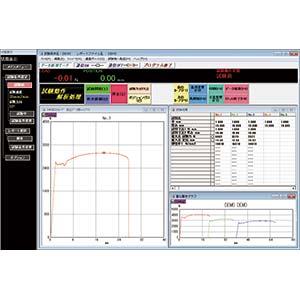Features

・ Analyzes the strength characteristics of various materials and products in conjunction with a tensile-compression testing machine.
・ Provides powerful report creating functions by allowing graphs and test results to be inserted into other applications, and graphs to be created freely, using output as [.txt] and [.wmf] format files.
・ Double graph screen allows single graphs and overlaid graphs within lots to be checked even while testing is in progress.
・ Additional tests are possible even after the lot has been completed.
Specification
| Specification name | Specification contents |
|---|---|
| System requirements | |
| Compatible operating | Windows10 (*Windows is the registered trade mark in the United States and other nations of Microsoft Corporation ) |
| CPU | Intel Pentium (Dual core or Single core) Clock speed 2 GHz or more |
| Memory | 1GB or more |
| Input device | CD/DVD drive x 1 unit |
| Outptu device | USB port (for the standard sampling spec.) |
| Specifications | |
| Standard testing software SR-09-001 (for LTS-B series) | Supports tensile, compression, bending (3-/4-point) testing. Equations and items can be alteredas required. |
| Analysis items | Test sample cross-sectional area, Elastic modulus, Elasticity gradient (spring constant) (up to 3 points), Upper yield point, Lower yield point, Yield strength point, Intermediate test force point (up to 6 points), Intermediate displacement point (Up to 6 points), Maximum test force point, Rupture point The testing force, the stress, sisplacement and the strain have been calculated, Initial tensile resistance, fineness, and specific gravity can be analyzed for thread testing. Statistical processing (up to 50 in lot) Mean value, standard deviation, standard deviation ×3, maximum value, minimum value, median, maximum value - minimum value, coefficient of variation, JIS K 6301 mean, sum, square of sum,number of N |
| Peeling, tearing, and friction test software SR-09-002 (for LTS-B series) | Supports 90°, 135°, 180° peeling testing, tearing testing, and friction testing. |
| Analysis items | Maximum peak point, minimum bottom point, First peak point, first bottom point, Rupture point, Intermediate displacement point (up to 6 points), Extension origin Test force, converted test force, unit test force, displacement, peeling distance Integral mean, Simple mean, Peak point mean, bottom point mean, Peak and bottom point mean, Tearing test force 6-point mean of small & large peak points, Mean of intermediate displacement for 2, 3, 4, 5 and 6 points, Collection mean, Tearing strength Test force, converted test force, unit test force Dynamic coefficient of friction, static coefficient of friction Energy, Number of peak and bottom points, Statistical processing (up to 50 in lot) Mean value, standard deviation, standard deviation × 3, maximum value, minimum value, median, maximum value - minimum value, coefficient of variation, JIS K 6301 mean, sum, square of sum, number of N |
